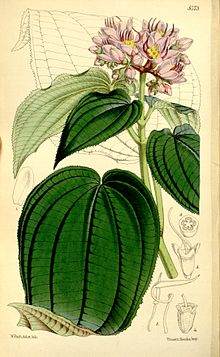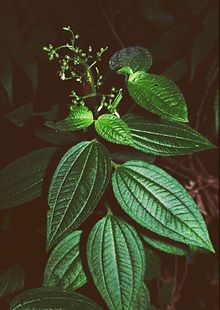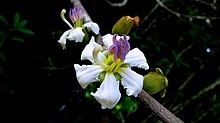Blackmouth plants
| Blackmouth plants | ||||||||||||
|---|---|---|---|---|---|---|---|---|---|---|---|---|
|
Miconia calvescens with the leaf veining of the opposite leaves typical of this family |
||||||||||||
| Systematics | ||||||||||||
|
||||||||||||
| Scientific name | ||||||||||||
| Melastomataceae | ||||||||||||
| Yuss. |
The Black Mouth Family (Melastomataceae) are a family of plants from the order of the myrtle-like (Myrtales). The approximately 4500 species are mainly in the tropics almost worldwide. Some species are used as ornamental plants .
Description and ecology



Two characteristics make the species of the subfamily Melastomatoideae almost always easily recognizable:
The vein of the leaf consists of three or more (up to nine) arched main veins from the base of the leaf to the tip of the leaf (looks a bit like parallel veins). These main veins are connected to one another by side veins branching off more or less at right angles.
The second typical feature of the subfamily Melastomatoideae (it is absent in some taxa) are the special appendages of the anthers with different shapes, but mostly awl-shaped or lanceolate appendages that are claw-shaped. In the picture of Tibouchina urvilleana, for example, the hook-shaped appendages are clearly visible. There are often several types of anthers in one flower.
Appearance and leaves
The species of the Melastomataceae are very diverse. There are annual to perennial herbaceous plants , including climbing plants , and woody taxa: shrubs , trees and lianas . They are one of the three-furrow pollen dicotyledonous families with the largest number of epiphytes . The young shoot axes are often square.
The simple leaves are always opposite or whorled . Only very few species are apparently alternate due to the reduction of one leaf per pair of leaves. The leaves are hairy in very different ways. There are no stipules.
Inflorescences, flowers, pollinators and fruits
The flowers are usually in multi-flowered inflorescences , rarely alone. The flowers of the Melastomatoideae subfamily are often intensely colored, with some species also being formed by bracts . The hermaphrodite flowers are radially symmetrical to strongly zygomorphic . The inflorescence is usually four or five-fold. Goblet and crown are provided on a axle formed by the flower petals mug the ovary encloses. The proportions of the generative flower organs are quite different.
The pollination is done by animals. In the Melastomataceae, nectar production is rare. Most species of the subfamily Melastomatoideae are visited by pollen-foraging bees, who use chest vibrations to shake the pollen through the anthers' pores. The characteristic anthers 'appendages function as a holder for the bees' legs.
The fruits are capsule fruits or berries depending on the tribe .
ingredients
Many of the Melastomataceae accumulate aluminum . The ash of some species can contain up to 20% Al ions.
use
Various species contain dyes in different parts of the plant. Black and yellow colors are particularly common. Some species are therefore also used as dye plants . For this reason, the edible berries of the Miconia genus leave a black mouth after consumption. A German name of the family is therefore also " Schwarzmundgewächse ".
Some species provide wood , for example Mouriri species (trade name: Pau ripa) and Dactyloclados stenostachys .
Some Tibouchina species are used as ornamental plants, often as street trees in the tropics ( e.g. Tibouchina granulosa , Tibouchina mutabilis ).
Occurrence
Overall, the Melastomataceae family is restricted to the tropics to subtropics around the world. Only one genus ( Rhexia ) occurs in temperate areas of North America. There are 3000 species in the Neotropic, 1000 species occur in Asia, 240 species are found in Africa and 230 species are native to Madagascar. Three genera occur only in Madagascar .
Most of the species in the Melastomataceae family belong to the herbaceous layer of tropical forests, and they are found in both rainforests and dry forests . Many of them can also be found in secondary societies that appear after the original forests have been disturbed.
Systematics
The Melastomataceae family was established in 1789 by Antoine Laurent de Jussieu in Genera Plantarum , p. 328, there called "Melastomae". Type genus is Melastoma L. Melastoma is made up of the Greek words mela for black and stoma for mouth, because when the edible, purple-blue berries of the type genus color the mouth black. Synonyms for Melastomataceae Juss. are: Memecylaceae DC. , Mouririaceae Gardner .
Important revisions to the systematics of the Melastomataceae family were made in the following works: Augustin-Pyrame de Candolle : Mémoires sur la famille des Mélastomacées , In: Prodromus Systematis Naturalis Regny Vegetabilis , Volume 3, 1828, pp. 99-102; Charles Victor Naudin : Melastomacearum monographicae descriptiones , Annales des Sciences Naturelles; Botanique , Series III, 1849-1853; José Jéronimo Triana : Les Melastomacées , In: Transactions of the Linnean Society of London , Volume 28, 1871, pp. 1–188; Célestin Alfred Cogniaux: Melastomaceae , Monograph Phanerogamarum , 7, 1891, pp. 1–1256; Susanne S. Renner : Phylogeny and classification of the Melastomataceae and Memecylaceae , In: Nordic Journal of Botany , Volume 13, 1993, pp. 519-540; Gudrun Clausing & Susanne S. Renner: Molecular phylogenetics of Melastomataceae and Memecylaceae: implications for character evolution , In: American Journal of Botany , Volume 88, Issue 3, 2001, pp. 486-498.
With 180 to 200 genera and 4500 species, the Melastomataceae family is the most species-rich of the order of the myrtle-like (Myrtales).
The family Melastomataceae again contains three subfamilies with 156 to 166 genera and 4050 to 4500 species (depending on whether the Olisbeoideae / Memecylaceae are included or not). There used to be another subfamily which, according to Renner 2006, is a separate family Crypteroniaceae . The subfamilies are divided into tribes.
- Subfamily Olisbeoideae Burnett , Syn .: Memecylaceae DC. : It contains six genera with 350 to 435 species almost worldwide.
- Subfamily Kibessioideae Naudin : It contains only one tribe:
- Tribus Kibessieae Krasser : It contains only one genus:
- Pternandra Jack : The 15 or so species are common in Southeast Asia.
- Tribus Kibessieae Krasser : It contains only one genus:
- Subfamily Melastomatoideae Naudin : According to Renner 1993 and Clausing & Renner 2001, it contains eight tribes, since then two tribes have been incorporated into others, one newly established and three reactivated, so that in 2013 there are ten tribes:
- Triana Astronieae Triana : It is common in Southeast Asia. It contains three to four genera Astrocalyx , Astronia , Astronidium , Beccarianthus (sometimes in Astronidium ) with a total of about 160 species.
- Tribus Blakeeae Benth. & Hook. f. (Syn .: Pyxidantheae Triana ): The only two instead of three genera Blakea and Chalybea with a total of 105 to 195 species are common in the Neotropic . The centers of biodiversity are the Choco Andes region in South America and the mountains in Costa Rica and Panama. There are species from the Mexican state of Chiapas to the Amazon region of Bolivia, Brazil and French Guyanas. Three types are found on the Caribbean islands. The mostly relatively large, showy flowers are six-fold. Pollination occurs by bees, birds, bats and rodents. Mites and ants live in communities with many species of this tribe in leaves and domatia on the shoot axes. Berries are formed.
- Tribe Cyphostyleae: According to Michelangeli 2011, it contains the three genera: Allomaieta , Alloneuron and Wurdastom with a total of around 18 species.
- Tribus Dissochaeteae (Naudin) Triana (Syn .: Oxysporeae Triana , Sonerileae Triana )
- Tribus Henrietteeae Penneys, Michelang., Judd & Almeda : It contains the three genera: Bellucia , Henriettea and Kirkbridea with a total of 50 to 87 species.
- Tribus Melastomeae (Syn .: Osbeckieae DC. ): The approximately 47 genera with 870 species are common both in the Paleotropic as well as in the Neotropic. The center of biodiversity is South America with 30 genera and around 570 species, 185 species occur in Africa, 50 species each are found in Madagascar, India, Indonesia and Malaysia and four species each are native to northern Australia and Japan. Capsule fruits are formed and the embryo is curved.
- Tribus Merianieae Triana : The about 16 genera with about 230 are common in the Neotropic. Capsule fruits are formed.
- Tribus Miconieae DC. : It is common in the Neotropics. Berries are formed.
- Tribus Microlicieae Naudin : It is widespread in the Neotropics, with about 90% of the species only occurring in the highlands of eastern and central Brazil. Since Michelangeli 2013 the six genera Chaetostoma , Lavoisiera , Microlicia , Rhynchanthera , Stenodon and Trembleya have been included.
- Tribe Rhexieae DC. : It was reactivated by Michelangeli in 2013 with the three genera Rhexia , Arthrostemma and Pachyloma .
- The following are not classified in one of the tribes:
- Macrocentrum Hook. f.
- Vietsenia C. Hansen

Habitus, leaves and fruits of Aciotis rubricaulis

Foliage leaves and flowers of Arthrostemma ciliatum

Flowers of the cauliflower Bellucia axinanthera

Habit, leaves and inflorescences of Bertolonia maculata

Flower buds and flowers of Brachyotum ledifolium

Inflorescence with yellow flowers of Cambessedesia espora

Habit and yellow flowers of Chaetolepis cufodontisii

Flower and fruits of Clidemia hirta

Foliage leaves and flowers of Heterotis rotundifolia (Sm.) Jacq.-Fél.) (Syn .: Dissotis rotundifolia (Sm.) Triana

Kauliflore, whitish flowers of Henriettea succosa

Habitus of Lavoisiera fragilis

Habit, leaves and flowers of Lavoisiera phyllocalycina

Inflorescences of Memecylon edule

Habit and inflorescences of Medinilla speciosa

Foliage leaves and flowers of Monochaetum vulcanicum

Kauliflore, white flowers of Mouriri pusa

Habit, leaves and flower of Pterolepis cataphracta

Flower of Rhexia mariana

Flower of Stenodon gracilis

Flower of Tibouchina semidecandra

Opposite leaves and inflorescences of Tococa guianensis
|
swell
- The Melastomataceae family with their subfamilies on the AP website. (Sections systematics and description)
- The Melastomataceae family at DELTA. (Section description)
- The website for the Melastomataceae family. (English)
- Jie Chen & Susanne S. Renner: Melastomataceae , p. 360 - the same text online as the printed work , In: Wu Zheng-yi, Peter H. Raven & Deyuan Hong (eds.): Flora of China , Volume 13 - Clusiaceae through Araliaceae , Science Press and Missouri Botanical Garden Press, Beijing and St. Louis, 2007. ISBN 978-1-930723-59-7 (Systematics and Description Sections)
- Susanne S. Renner: Phylogeny and classification of the Melastomataceae and Memecylaceae , In: Nordic Journal of Botany , Volume 13, 1993, pp. 519-540: full text PDF.
- Gudrun Clausing & Susanne S. Renner: Molecular phylogenetics of Melastomataceae and Memecylaceae: implications for character evolution , In: American Journal of Botany , Volume 88, Issue 3, 2001, pp. 486-498: full text PDF.
- Susanne S. Renner: Multiple Miocene Melastomataceae dispersal between Madagascar, Africa and India , In: Philosophical Transactions: Biological Sciences , Volume 359, Issue 1450, 2004, pp. 1485-1494. doi: 10.1098 / rstb.2004.1530
- Fabián A. Michelangeli, Paulo JF Guimaraes, Darin S. Penneys, Frank Almeda & Ricardo Kriebel: Phylogenetic relationships and distribution of New World Melastomeae (Melastomataceae) , In: Botanical Journal of the Linnean Society , Volume 171, Issue 1, 2013, p 38-60. doi: 10.1111 / j.1095-8339.2012.01295.x (section systematics)
Individual evidence
- ↑ a b c d e Elizabeth M. Woodgyer, 2009: Neotropical Melastomataceae at neotropikey - Neotropical Flowering Plants .
- ↑ First publication scanned at biodiversitylibrary.org .
- ↑ Melastomataceae at Tropicos.org. Missouri Botanical Garden, St. Louis, accessed September 30, 2013.
- ^ A b Melastomataceae in the Germplasm Resources Information Network (GRIN), USDA , ARS , National Genetic Resources Program. National Germplasm Resources Laboratory, Beltsville, Maryland. Retrieved September 30, 2013.
- ↑ a b c Elizabeth M. Woodgyer, 2009: Neotropical Memecylaceae at neotropikey - Neotropical Flowering Plants .
- ↑ RDStone: Phylogeny of major lineages in Melastomataceae subfamily Olisbeoideae: Utility of nuclear glyceraldehyde 3-phosphate dehydrogenase (GapC) gene sequences , In: Systematic Botany , Volume 31, Issue 1, 2006, pp. 107-121.
- ↑ a b c d e f g h i j k l m n o p q r s t u v w x y z aa ab ac ad ae af ag ah ai Frank Almeda: Melastomataceae - online with the same text as the printed work , In: G Davidse, M. Sousa Sánchez, S. Knapp, F. Chiang (Eds.): Flora Mesoamericana , Volume 4 (1) - Cucurbitaceae a Polemoniaceae , 2009, Universidad Nacional Autónoma de México, Missouri Botanical Garden, St. Louis, The Natural History Museum, London. ISBN 978-6-07-020901-7 .
- ↑ a b c d e f g Fabián A. Michelangeli, Paulo JF Guimaraes, Darin S. Penneys, Frank Almeda & Ricardo Kriebel: Phylogenetic relationships and distribution of New World Melastomeae (Melastomataceae) , In: Botanical Journal of the Linnean Society , Volume 171, Issue 1, 2013, pp. 38-60. doi: 10.1111 / j.1095-8339.2012.01295.x
- ↑ Darin S. Penneys & Walter S. Judd: Phylogenetics and morphology in the Blakeeae (Melastomataceae) , In: International Journal of Plant Sciences , Volume 172, 2011, pp. 78-106.
- ↑ a b c Darin S. Penneys & Walter S. Judd: A revised circumscription for the Blakeeae (Melastomataceae) with associated nomenclatural adjustments , In: PhytoKeys , 20, 2013, pp. 17-32. doi: 10.3897 / phytokeys.20.4344
- ↑ a b c d Fabián A. Michelangeli, Antoine Nicolas, María Eugenia Morales-P & Heriberto David: Phylogenetic Relationships of Allomaieta, Alloneuron, Cyphostyla, and Wurdastom (Melastomataceae) and the Resurrection of the Tribe Cyphostyleae , In: International Journal of Plant Sciences , Volume 172, Issue 9, 2011, pp. 1165-1178. doi: 10.1086 / 662032
- ↑ a b c d Darin S. Penneys, Fabián A. Michelangeli, Walter S. Judd & Frank Almeda: Henrietteeae (Melastomataceae): A new Neotropical berry-fruited tribe , In: Systematic Botany , Volume 35, Issue 4, 2010, p 783-800. doi: 10.1600 / 036364410X539862
- ↑ Peter W. Fritsch, Frank Almeda, Susanne S. Renner, AB Martins & BC Cruz: Phylogeny and circumscription of the near-endemic Brazilian tribe Microlicieae (Melastomataceae) , In: American Journal of Botany , Volume 91, 2004, p. 1105 -1114.
- ↑ a b c d e f g h i j k l m n o p q r s t u v Jie Chen & Susanne S. Renner: Melastomataceae , p. 360 - online with the same text as the printed work , In: Wu Zheng-yi, Peter H. Raven & Deyuan Hong (Eds.): Flora of China , Volume 13 - Clusiaceae through Araliaceae , Science Press and Missouri Botanical Garden Press, Beijing and St. Louis, 2007. ISBN 978-1-930723-59-7
- ↑ a b c d e Susanne S. Renner: Phylogeny and classification of the Melastomataceae and Memecylaceae , In: Nordic Journal of Botany , Volume 13, 1993, pp. 519-540: Volltext-PDF.
- ↑ a b c d e f g h i j k l The Melastomataceae family in the Andes of Ecuador - Trees and shrubs of the Andes of Ecuador . (span.)
Web links
further reading
- Fabián A. Michelangeli, Walter S. Judd, Darin S. Penneys, JD Skean, ER Becquer-Granados, R. Goldenberg & CV Martin: Multiple events of dispersal and radiation of the tribe Miconieae (Melastomataceae) in the Caribbean , In: The Botanical Review , Volume 74, Issue 1, 2008, pp. 53-77.
- Steven Jansen, Toshihiro Watanabe & Erik Smets: Aluminum Accumulation in Leaves of 127 Species in Melastomataceae, with Comments on the Order Myrtales , In: Annals of Botany , Volume 90, Issue 1, pp. 53-64.





